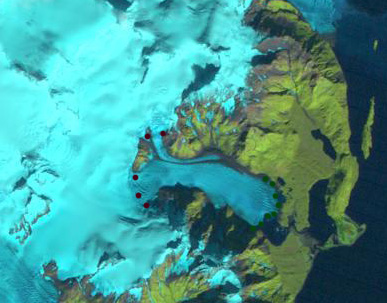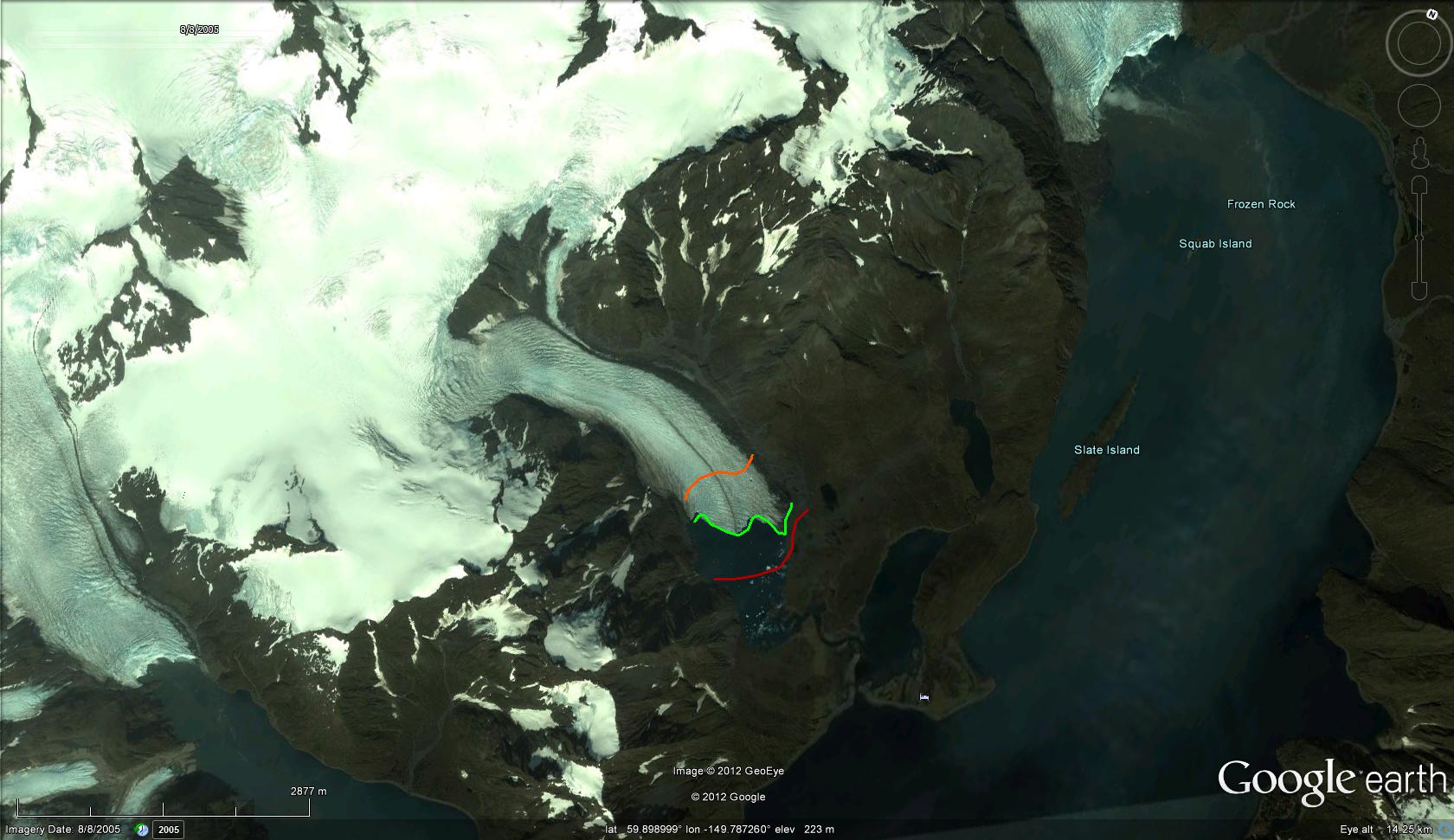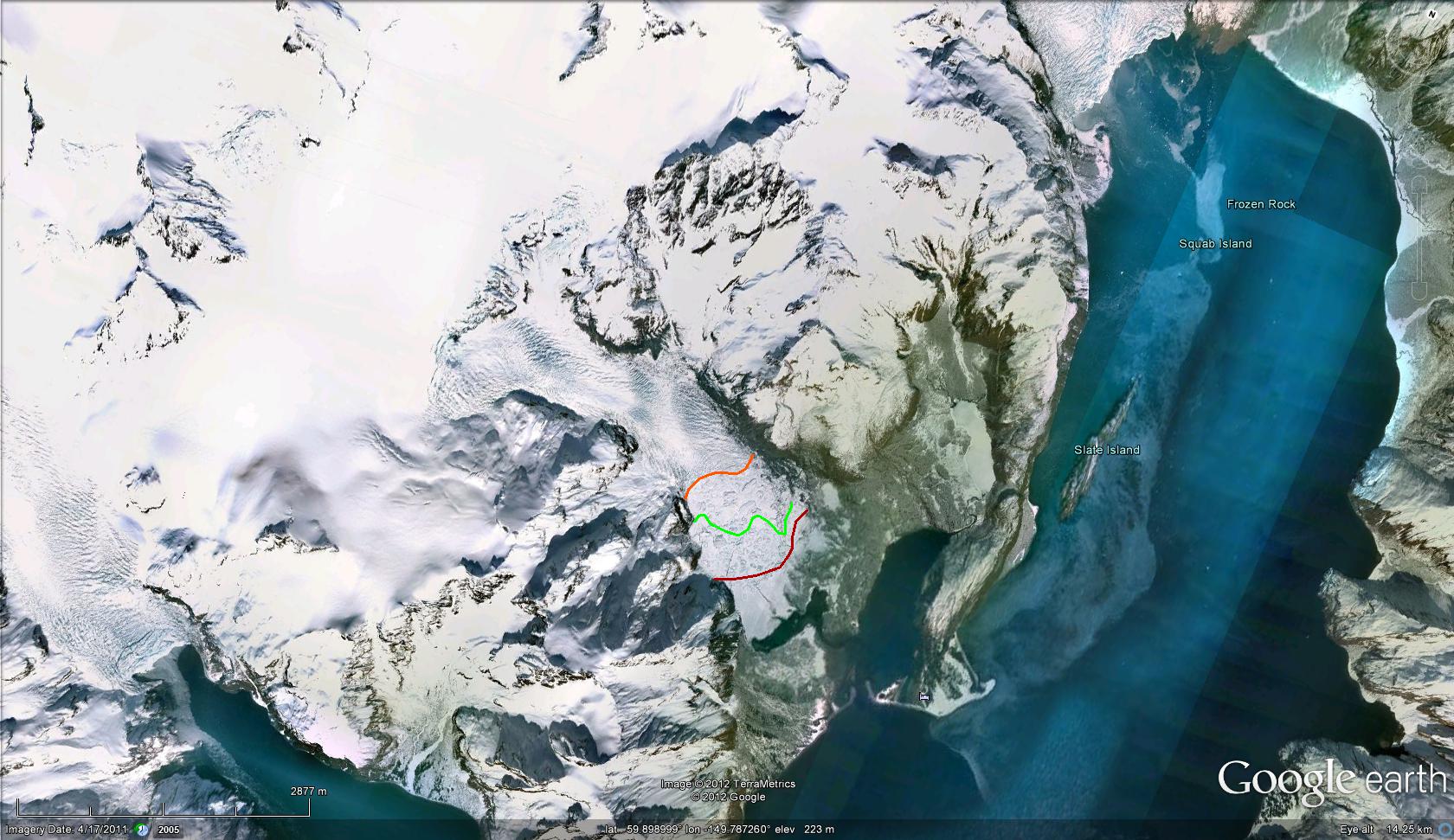June 23, 2012
Pedersen Glacier Retreat Lake Expansion, Alaska
Posted by Mauri Pelto
Pedersen Glacier is an outlet glacier of the Harding Icefield in Kenai Fjords National Park near Seward, Alaska. The glacier drops quickly from the plateau of the icefield through a pair of icefalls terminating 3.5 km in a lake at 25 meters. Bruce Molnia of the USGS as part of an effort in repeat photographs of Alaskan glaciers to show historic changes captures the changes of Pedersen Glacier. A photographic pair taken from about the same shoreline location of Pedersen Glacier. The photographs identify significant changes that have occurred during the 95 years between 1909 and 2004. The 2004 photograph a 1.5 km retreat of Pedersen Glacier from the field of view.  In a recent study of the glaciers, by NASA and the NPS, (Hall et al, 2005) identify the retreat of the glacier as slow but steady from 1973-1986 at 510 m (35 m/a) and 110 m (8 m/year) from 1986-2000. Here we compare a 1994 Landsat, 2005 Google Earth, 2010 Landsat and 2011 Google Earth imagery illustrating a rapid increase in retreat rate from the previous periods. The red line in the Google Earth images is the 1994 terminus, the green line the 2005 terminus and the orange line the 2011 terminus. In 1994 the lake at the terminus is small and not continuous across the ice front (top image), the green dots are the terminus and the burgundy dots the snowline on the date of the image, near the top of the icefall. In the second image from 2005 the lake is now well developed but the number of icebergs in the lake limited. The third image from 2010 indicates a rapid lake expansion which is now largely filled by icebergs. In 2011 the lake remains filled with some very large icebergs indicating the recent nature of terminus collapse in the lake. The retreat from 1994-2005 was 450 meters (40 m/year) and 650 meters from 2005-2011,(110 m/year). The snowline is somewhat above the top of the icefalls on Pedersen Glacier.
In a recent study of the glaciers, by NASA and the NPS, (Hall et al, 2005) identify the retreat of the glacier as slow but steady from 1973-1986 at 510 m (35 m/a) and 110 m (8 m/year) from 1986-2000. Here we compare a 1994 Landsat, 2005 Google Earth, 2010 Landsat and 2011 Google Earth imagery illustrating a rapid increase in retreat rate from the previous periods. The red line in the Google Earth images is the 1994 terminus, the green line the 2005 terminus and the orange line the 2011 terminus. In 1994 the lake at the terminus is small and not continuous across the ice front (top image), the green dots are the terminus and the burgundy dots the snowline on the date of the image, near the top of the icefall. In the second image from 2005 the lake is now well developed but the number of icebergs in the lake limited. The third image from 2010 indicates a rapid lake expansion which is now largely filled by icebergs. In 2011 the lake remains filled with some very large icebergs indicating the recent nature of terminus collapse in the lake. The retreat from 1994-2005 was 450 meters (40 m/year) and 650 meters from 2005-2011,(110 m/year). The snowline is somewhat above the top of the icefalls on Pedersen Glacier.  .
.

 . A closeup view of the terminus area from 2005 and 2011 indicate that the lake has more than doubled in size since 1994, and there is no distinct change in glacier width or surface elevation to suggest the glacier is near a point where the rapid terminus retreat will end. The glacier follows the pattern of nearby Bear Glacier, Yakutat Glacier, Gilkey Glacier and the predicted impending retreat of Brady Glacier.
. A closeup view of the terminus area from 2005 and 2011 indicate that the lake has more than doubled in size since 1994, and there is no distinct change in glacier width or surface elevation to suggest the glacier is near a point where the rapid terminus retreat will end. The glacier follows the pattern of nearby Bear Glacier, Yakutat Glacier, Gilkey Glacier and the predicted impending retreat of Brady Glacier. 



 Dean of Academic Affairs at Nichols College and Professor of Environmental Science at Nichols College in Massachusetts since 1989. Glaciologist directing the North Cascade Glacier Climate Project since 1984. This project monitors the mass balance and behavior of more glaciers than any other in North America.
Dean of Academic Affairs at Nichols College and Professor of Environmental Science at Nichols College in Massachusetts since 1989. Glaciologist directing the North Cascade Glacier Climate Project since 1984. This project monitors the mass balance and behavior of more glaciers than any other in North America.
I visited the Pedersen Glacier in 2000. I stood on the deck of the ferry and saw for myself the calving and retreat of this glacier which the volunteer ranger told us was so rapid it was “very scary.” I agree. As some keen observer said, “We have awakened giants.” If we would like to have a future for our children, we have to ween ourselves off of fossil fuels as quickly as possible.
Phaedra Greenwood